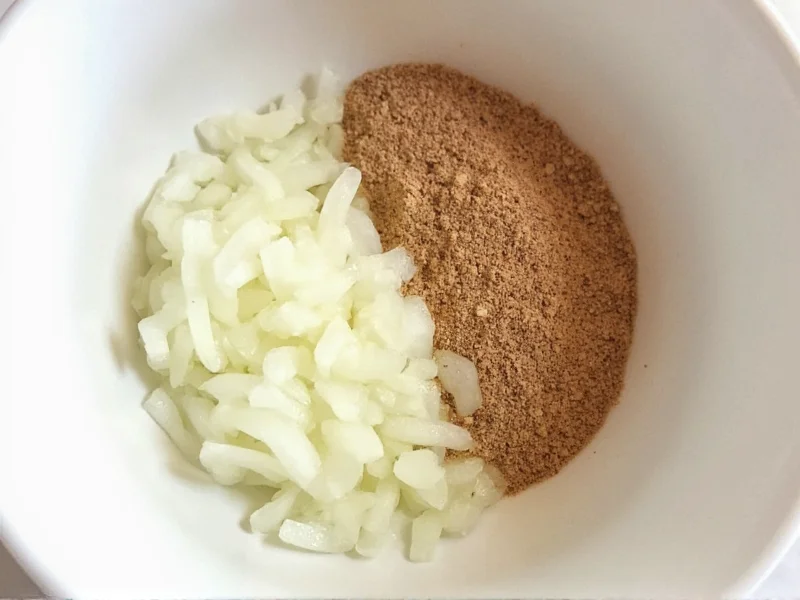Converting fresh onions to onion powder requires understanding the fundamental relationship between these two forms of the same ingredient. When recipes call for specific measurements of fresh onion but you only have onion powder available (or vice versa), knowing the precise conversion ratio prevents cooking disasters and ensures your dishes maintain proper flavor balance.
Understanding the Onion Conversion Ratio
The standard culinary conversion is straightforward: 1 tablespoon of fresh chopped onion equals ¼ teaspoon of onion powder. Therefore, when a recipe specifies ¼ cup of fresh onion (which equals 4 tablespoons), you'll need exactly 1 teaspoon of onion powder as a substitute.
This ratio exists because the dehydration process removes approximately 90% of the onion's water content, concentrating the flavor compounds into a much smaller volume. Commercial onion powder typically undergoes drying at controlled temperatures to preserve flavor compounds while eliminating moisture that could cause spoilage.
Factors Affecting Onion Powder Conversions
While the standard ratio works for most applications, several variables can influence your substitution:
- Onion variety - Yellow onions have stronger flavor than sweet varieties
- Moisture content - Home-dried powder may differ from commercial products
- Packaging density - How tightly you pack the powder affects volume
- Recipe type - Liquid-based dishes may require slight adjustments
| Fresh Onion Measurement | Onion Powder Equivalent |
|---|---|
| 1 tablespoon | ¼ teaspoon |
| ¼ cup (4 tablespoons) | 1 teaspoon |
| ½ cup | 2 teaspoons |
| 1 cup | 1 tablespoon + ½ teaspoon |
| 1 medium onion (chopped) | 1½ tablespoons |
Practical Substitution Guidelines
When substituting onion powder for fresh onion in recipes, consider these professional cooking tips:
For dry recipes like spice rubs, meatloaf, or bread dough, use the standard conversion ratio without adjustment. The powder integrates evenly without introducing additional moisture that could affect texture.
In liquid-based recipes such as soups, stews, or sauces, add 1-2 teaspoons of water along with the onion powder to compensate for the missing moisture from fresh onion. This prevents your dish from becoming too concentrated.
When reversing the substitution (using fresh onion instead of powder), remember that fresh onion contains water that may alter your recipe's liquid balance. For every teaspoon of onion powder replaced, use 1 tablespoon of finely minced fresh onion and reduce other liquids by 1 teaspoon.
When Fresh Onion Works Better Than Powder
Certain culinary applications benefit from using fresh onion rather than powder:
- Salsas and fresh relishes where texture matters
- Grilled or roasted vegetable dishes
- Raw applications like salads or ceviche
- Recipes where visual appeal of onion pieces is important
When Onion Powder Provides Superior Results
Conversely, onion powder shines in these situations:
- Spice blends and dry rubs where even distribution is crucial
- Thick sauces where fresh onion might not fully dissolve
- Long-cooking dishes where fresh onion would break down completely
- Emergency substitutions when fresh onions aren't available
Common Conversion Mistakes to Avoid
Cooks frequently make these errors when converting 1/4 onion to onion powder:
- Using tablespoon instead of teaspoon measurements for powder
- Not adjusting liquid content in the recipe
- Assuming all onion powders have identical strength
- Substituting without considering the dish's cooking time
- Measuring powder by weight instead of volume
For best results with ¼ cup fresh onion to onion powder conversions, always measure powder using proper measuring spoons rather than estimating. Store unused powder in an airtight container away from light and moisture to maintain potency for up to 18 months.
How much onion powder equals 1/4 cup of fresh onion?
One teaspoon of onion powder equals ¼ cup of fresh chopped onion. This standard conversion accounts for the dehydration process that concentrates the onion flavor while removing moisture.
Can I substitute onion powder for fresh onion in all recipes?
While onion powder works well in most cooked dishes, it's not ideal for recipes where fresh onion texture or appearance matters, such as salsas, salads, or grilled dishes. For liquid-based recipes, add 1-2 teaspoons of water with the powder to compensate for missing moisture.
Why does 1/4 onion equal 1 teaspoon of powder instead of more?
The dehydration process removes approximately 90% of the onion's water content, concentrating the flavor compounds. This means the powder delivers the same flavor intensity in a much smaller volume - hence ¼ cup fresh onion (4 tablespoons) converts to just 1 teaspoon of powder.
Does the type of onion affect the conversion ratio?
Yes, yellow onions have stronger flavor than sweet varieties like Vidalia, so you might use slightly less powder when substituting for sweet onions. However, for most home cooking applications, the standard 1 teaspoon per ¼ cup ratio works well regardless of onion type.
How do I adjust recipes when converting from onion powder to fresh onion?
For each teaspoon of onion powder, use 1 tablespoon of finely minced fresh onion and reduce other liquids in the recipe by 1 teaspoon. This compensates for the additional moisture fresh onion introduces to the dish.











 浙公网安备
33010002000092号
浙公网安备
33010002000092号 浙B2-20120091-4
浙B2-20120091-4